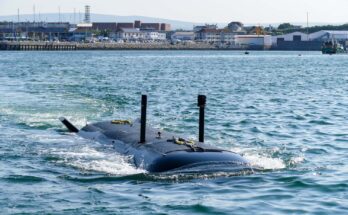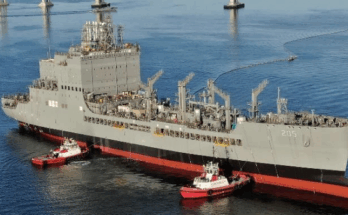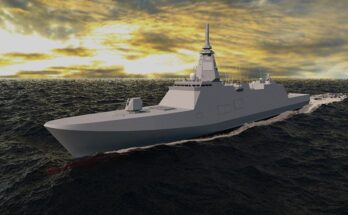by Stuart Slade, Warships Analyst, Forecast International.
Within a period of 20 years, dating from around 1960, when the first production gas turbine-powered ships entered service, to the early 1980s, marine gas turbines effectively destroyed the century-old steam turbine industry. This process involved not just the substitution of gas turbines for the existing combination of boilers and steam turbines, but also extensive changes to the logistics and support systems that had grown up around steam. Gas turbines required a lighter grade of fuel to run the most efficiently, and the processes by which they are maintained are completely different. The net effect was that, once the switch to gas turbines was made, going back was impossible. The marine steam turbine industry was dead.
Now, gas turbines appear to be on the verge of eliminating another marine engineering sector –gearing. As was the case with the replacement of steam, the ramifications of a move away from gearing in maritime powertrains will extend beyond the simple replacement of equipment.
Gearing became critical when steam turbines arrived as a major power source. Steam turbines work best when turning the shafts at high speeds; propellers work best when turning relatively slowly. The first steam turbine ships had their turbines directly connected to the propellers (direct drive), but their fuel consumption was excessive and the efficiency of the powertrain was low. Introducing a set of gears between the steam turbines and the propeller shafts to reduce the rate of revolution transmitted to the shafts was a major step forward. Single reduction gearing was replaced by double reduction with a further increase in efficiency, but whether powered by steam turbines or gas turbines, gearing remained a vital intermediate step.
The main reduction gearbox in a maritime powertrain is a complex and problem-plagued item. The stresses involved in transitioning from the fast-spinning turbine shaft to the slowly turning propeller shaft are great and can only be accommodated by robust engineering. Vibration from the propellers and shafts can quickly wreck the bearings and glands if they are not damped, and this vibration also requires mass in the gearbox. Another consideration is noise; the operation of the gearbox is inherently noisy and this also needs to be damped. The result is that the gearbox is a massively over-engineered piece of equipment that consumes a disproportionate amount of weight. Yet, for all that it is also delicate, and mishandling or abuse can easily result in prolonged downtime and crippling repair costs. Also, the manufacture of gears is a precise and highly skilled process that takes time. Gear-cutting capacity is a major bottleneck in industrial infrastructure.
Now, there is an answer to these issues. Integrated Fully Electric Propulsion (IFEP) sees the gas turbines (and diesels if present) not configured as drives but as generators providing electrical power to motors. This configuration eliminates gears completely. The electric motors can be positioned well aft, reducing the length of the propeller shafts and thus increasing efficiency. Electric motors are almost silent, are much lighter than conventional gearing, and are easier to maintain.
The real benefit of shifting to an electric propulsion system, though, lies in the way the power is used. Modern ship control technology has allowed the electrical power generated by the ship’s machinery to be fed into a common pool for allocation as required by the operational circumstances. If the need is for a high-speed run, power goes to the electric motors; if the requirement is to enhance situational awareness, power can be allocated to the sensors and, if necessary, to the weapons. In effect, the distinction between propulsion power and ship’s service power has been eliminated. Both are simply alternative positions on a spectrum of power use.
The development of IFEP is likely to change the way navies look at warship design. The reason why a ship’s machinery was placed low down in the hull was that its weight precluded placing it anywhere else. This factor was diluted by the introduction of gas turbines that eliminated the heavy boilers and reduced the weight of the turbines. However, the major weight contribution of the main reduction gearing meant that the powertrain had to remain low down. Now, with that gearing gone, the number of design options has multiplied.
Gas turbines are relatively light in proportion to their power output. This means that they can be placed above the waterline, possibly even in the superstructure. This eases access for maintenance and reduces sound signature. It also frees up the well-protected areas deep in the ship for munitions stowage or other purposes, or for use as command control facilities. Repositioning the gas turbines also means that the volume used for air intakes and exhaust ducting can be reduced, resulting in a more efficient internal layout.
The advantages brought about by the successful development of IFEP are so compelling that it is hard to avoid the conclusion that this will become the standard powertrain configuration within a few years. It took 20 years for gas turbines to eliminate steam; it is hard to see gearing surviving any longer than that. Now is probably not a good time to invest in a marine gear-cutting company.
Return to Forecast International homepage
For 50 years, Forecast International intelligence reports have been the aerospace and defense industry standard for accurate research, analysis, and projections. Our experienced analysts compile, evaluate, and present accurate data for decision makers. FI's market research reports offer concise analysis of individual programs and identify market opportunities. Each report includes a program overview, detailed statistics, recent developments and a competitive analysis, culminating in production forecasts spanning 10 or 15 years. Let our market intelligence reports be a key part of reducing uncertainties and mastering your specific market and its growth potential. Find out more at www.forecastinternational.com



